Chapter-08 Heredity
We have seen that reproductive processes give rise to new individuals that are similar, but subtly different. We have discussed how some amount of variation is produced even during asexual reproduction. And the number of successful variations are maximised by the process of sexual reproduction. If we observe a field of sugarcane we find very little variations among the individual plants. But in a number of animals including human beings, which reproduce sexually, quite distinct variations are visible among different individuals. In this chapter, we shall be studying the mechanism by which variations are created and inherited.
8.1 ACCUMULATION OF VARIATION DURING REPRODUCTION
Inheritance from the previous generation provides both a common basic body design, and subtle changes in it, for the next generation. Now think about what would happen when this new generation, in its turn, reproduces. The second generation will have differences that they inherit from the first generation, as well as newly created differences (Fig. 8.1).
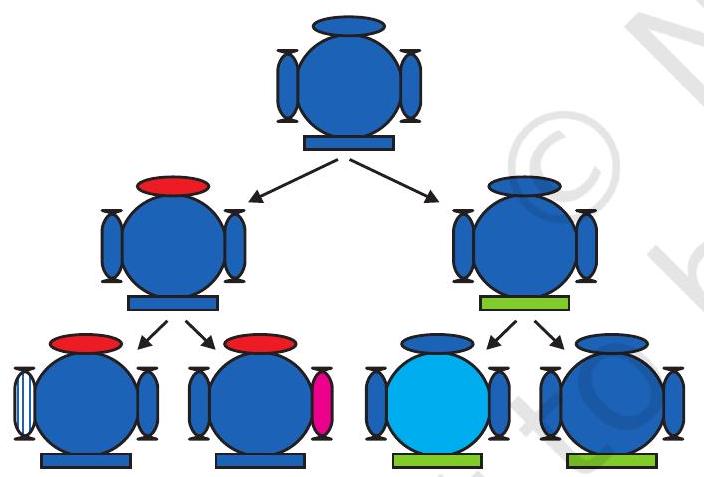
Figure 8.1 Creation of diversity over succeeding generations. The original organism at the top will give rise to, say, two individuals, similar in body design, but with subtle differences. Each of them, in turn, will give rise to two individuals in the next generation. Each of the four individuals in the bottom row will be different from each other. While some of these differences will be unique, others will be inherited from their respective parents, who were different from each other.
Figure 8.1 would represent the situation if a single individual reproduces, as happens in asexual reproduction. If one bacterium divides, and then the resultant two bacteria divide again, the four individual bacteria generated would be very similar. There would be only very minor differences between them, generated due to small inaccuracies in DNA copying. However, if sexual reproduction is involved, even greater diversity will be generated, as we will see when we discuss the rules of inheritance.
Do all these variations in a species have equal chances of surviving in the environment in which they find themselves? Obviously not. Depending on the nature of variations, different individuals would have different kinds of advantages. Bacteria that can withstand heat will survive better in a heat wave, as we have discussed earlier. Selection of variants by environmental factors forms the basis for evolutionary processes, as we will discuss in later sections.
QUESTIONS
1. If a trait A exists in $10 \%$ of a population of an asexually reproducing species and a trait B exists in $60 \%$ of the same population, which trait is likely to have arisen earlier?
Show Answer
Answer
In asexual reproduction, the reproducing cells produce a copy of their DNA through some chemical reactions. However, this copying of DNA is not accurate and therefore, the newly formed DNA has some variations.

It can be easily observed in the above figure that in asexual reproduction, very few variations are allowed. Therefore, if a trait is present in only $10 \%$ of the population, it is more likely that the trait has arisen recently. Hence, it can be concluded that trait B that exists in $60 \%$ of the same population has arisen earlier than trait A.
2. How does the creation of variations in a species promote survival?
Show Answer
Answer
Sometimes for a species, the environmental conditions change so drastically that their survival becomes difficult. For example, if the temperature of water increases suddenly, most of the bacteria living in that water would die. Only few variants resistant to heat would be able to survive. If these variants were not there, then the entire species of bacteria would have been destroyed. Thus, these variants help in the survival of the species.
However, not all variations are useful. Therefore, these are not necessarily beneficial for the individual organisms.
8.2 HEREDITY
The most obvious outcome of the reproductive process still remains the generation of individuals of similar design. The rules of heredity determine the process by which traits and characteristics are reliably inherited. Let us take a closer look at these rules.
8.2.1 Inherited Traits
What exactly do we mean by similarities and differences? We know that a child bears all the basic features of a human being. However, it does not look exactly like its parents, and human populations show a great deal of variation.
Activity 8.1
- Observe the ears of all the students in the class. Prepare a list of students having free or attached earlobes and calculate the percentage of students having each (Fig. 8.2). Find out about the earlobes of the parents of each student in the class. Correlate the earlobe type of each student with that of their parents. Based on this evidence, suggest a possible rule for the inheritance of earlobe types.

(a)
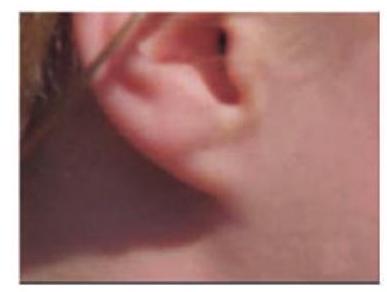
(b)
Figure 8.2 (a) Free and (b) attached earlobes. The lowest part of the ear, called the earlobe, is closely attached to the side of the head in some of us, and not in others. Free and attached earlobes are two variants found in human populations.
8.2.2 Rules for the Inheritance of Traits Mendel’s Contributions
The rules for inheritance of such traits in human beings are related to the fact that both the father and the mother contribute practically equal amounts of genetic material to the child. This means that each trait can be influenced by both paternal and maternal DNA. Thus, for each trait there will be two versions in each child. What will, then, the trait seen in the child be? Mendel (see box) worked out the main rules of such inheritance, and it is interesting to look at some of his experiments from more than a century ago.
Gregor Johann Mendel (1822-1884)
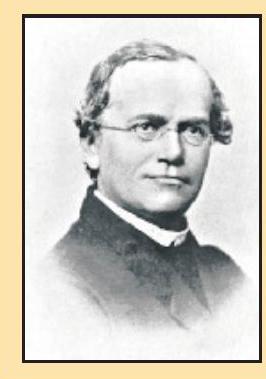
Mendel was educated in a monastery and went on to study science and mathematics at the University of Vienna. Failure in the examinations for a teaching certificate did not suppress his zeal for scientific quest. He went back to his monastery and started growing peas. Many others had studied the inheritance of traits in peas and other organisms earlier, but Mendel blended his knowledge of science and mathematics and was the first one to keep count of individuals exhibiting a particular trait in each generation. This helped him to arrive at the laws of inheritance.
Mendel used a number of contrasting visible characters of garden peas - round/wrinkled seeds, tall/short plants, white/violet flowers and so on. He took pea plants with different characteristics - a tall plant and a short plant, produced progeny by crossing them, and calculated the percentages of tall or short progeny.
In the first place, there were no halfway characteristics in this firstgeneration, or $F 1$ progeny - no ‘medium-height’ plants. All plants were tall. This meant that only one of the parental traits was seen, not some mixture of the two. So the next question was, were the tall plants in the $\mathrm{F_1}$ generation exactly the same as the tall plants of the parent generation? Mendelian experiments test this by getting both the parental plants and these $\mathrm{F_1}$ tall plants to reproduce by self-pollination. The progeny of the parental plants are, of course, all tall. However, the second-generation, or $\mathrm{F_2}$, progeny of the $\mathrm{F_1}$ tall plants are not all tall. Instead, one quarter of them are short. This indicates that both the tallness and shortness traits were inherited in the $\mathrm{F_1}$ plants, but only the tallness trait was expressed. This led Mendel to propose that two copies of factor (now called genes) controlling traits are present in sexually reproducing organism. These two may be identical, or may be different, depending on the parentage. A pattern of inheritance can be worked out with this assumption, as shown in Fig. 8.3.

Figure 8.3 Inheritance of traits over two generations
Activity 8.2
- In Fig. 8.3, what experiment would we do to confirm that the $\mathrm{F_2}$ generation did in fact have a 1:2:1 ratio of $TT$, $Tt$ and tt trait combinations?
In this explanation, both $TT$ and $Tt$ are tall plants, while only tt is a short plant. In other words, a single copy of ’ $T$ ’ is enough to make the plant tall, while both copies have to be ’ $t$ ’ for the plant to be short. Traits like ’ $T$ ’ are called dominant traits, while those that behave like ’ $t$ ’ are called recessive traits. Work out which trait would be considered dominant and which one recessive in Fig. 8.4.

Figure 8.4
What happens when pea plants showing two different characteristics, rather than just one, are bred with each other? What do the progeny of a tall plant with round seeds and a short plant with wrinkled-seeds look like? They are all tall and have round seeds. Tallness and round seeds are thus dominant traits. But what happens when these $\mathrm{F_1}$ progeny are used to generate $\mathrm{F_2}$ progeny by self-pollination? A Mendelian experiment will find that some $\mathrm{F_2}$ progeny are tall plants with round seeds, and some were short plants with wrinkled seeds. However, there would also be some $\mathrm{F_2}$ progeny that showed new combinations. Some of them would be tall, but have wrinkled seeds, while others would be short, but have round seeds. You can see as to how new combinations of traits are formed in $\mathrm{F_2}$ offspring when factors controlling for seed shape and seed colour recombine to form zygote leading to form $\mathrm{F_2}$ offspring (Fig. 8.5). Thus, the tall/short trait and the round seed/wrinkled seed trait are independently inherited.

Figure 8.5 Independent inheritance of two separate traits, shape and colour of seeds
8.2.3 How do these Traits get Expressed?
How does the mechanism of heredity work? Cellular DNA is the information source for making proteins in the cell. A section of DNA that provides information for one protein is called the gene for that protein. How do proteins control the characteristics that we are discussing here? Let us take the example of tallness as a characteristic. We know that plants have hormones that can trigger growth. Plant height can thus depend on the amount of a particular plant hormone. The amount of the plant hormone made will depend on the efficiency of the process for making it. Consider now an enzyme that is important for this process. If this enzyme works efficiently, a lot of hormone will be made, and the plant will be tall. If the gene for that enzyme has an alteration that makes the enzyme less efficient, the amount of hormone will be less, and the plant will be short. Thus, genes control characteristics, or traits.
If the interpretations of Mendelian experiments we have been discussing are correct, then both parents must be contributing equally to the DNA of the progeny during sexual reproduction. We have disscussed this issue in the previous Chapter. If both parents can help determine the trait in the progeny, both parents must be contributing a copy of the same gene. This means that each pea plant must have two sets of all genes, one inherited from each parent. For this mechanism to work, each germ cell must have only one gene set.
How do germ-cells make a single set of genes from the normal two copies that all other cells in the body have? If progeny plants inherited a single whole gene set from each parent, then the experiment explained in Fig. 8.5 cannot work. This is because the two characteristics ’ $R$ ’ and ’ $y$ ’ would then be linked to each other and cannot be independently inherited. This is explained by the fact that each gene set is present, not as a single long thread of DNA, but as separate independent pieces, each called a chromosome. Thus, each cell will have two copies of each chromosome, one each from the male and female parents. Every germcell will take one chromosome from each pair and these may be of either maternal or paternal origin. When two germ cells combine, they will restore the normal number of chromosomes in the progeny, ensuring the stability of the DNA of the species. Such a mechanism of inheritance explains the results of the Mendel experiments, and is used by all sexually reproducing organisms. But asexually reproducing organisms also follow similar rules of inheritance. Can we work out how their inheritance might work?
8.2.4 Sex Determination
We have discussed the idea that the two sexes participating in sexual reproduction must be somewhat different from each other for a number of reasons. How is the sex of a newborn individual determined? Different species use very different strategies for this. Some rely entirely on environmental cues. Thus, in some animals like a few reptiles, the temperature at which fertilised eggs are kept determines whether the animals developing in the eggs will be male or female. In other animals, such as snails, individuals can change sex, indicating that sex is not genetically determined. However, in human beings, the sex of the individual is largely genetically determined. In other words, the genes inherited from our parents decide whether we will be boys or girls. But so far, we have assumed that similar gene sets are inherited from both parents. If that is the case, how can genetic inheritance determine sex?

Figure 8.6 Sex determination in human beings
The explanation lies in the fact that all human chromosomes are not paired. Most human chromosomes have a maternal and a paternal copy, and we have 22 such pairs. But one pair, called the sex chromosomes, is odd in not always being a perfect pair. Women have a perfect pair of sex chromosomes, both called X. But men have a mismatched pair in which one is a normal-sized X while the other is a short one called Y. So women are XX, while men are XY. Now, can we work out what the inheritance pattern of $X$ and $Y$ will be?
As Fig. 8.6 shows, half the children will be boys and half will be girls. All children will inherit an X chromosome from their mother regardless of whether they are boys or girls. Thus, the sex of the children will be determined by what they inherit from their father. A child who inherits an $X$ chromosome from her father will be a girl, and one who inherits a $Y$ chromosome from him will be a boy.
QUESTIONS
1. How do Mendel’s experiments show that traits may be dominant or recessive?
Show Answer
Answer
Mendel selected true breeding tall (TT) and dwarf (tt) pea plants. Then, he crossed these two plants. The seeds formed after fertilization were grown and these plants that were formed represent the first filial or $\mathrm{F_1}$ generation. All the $\mathrm{F_1}$ plants obtained were tall.
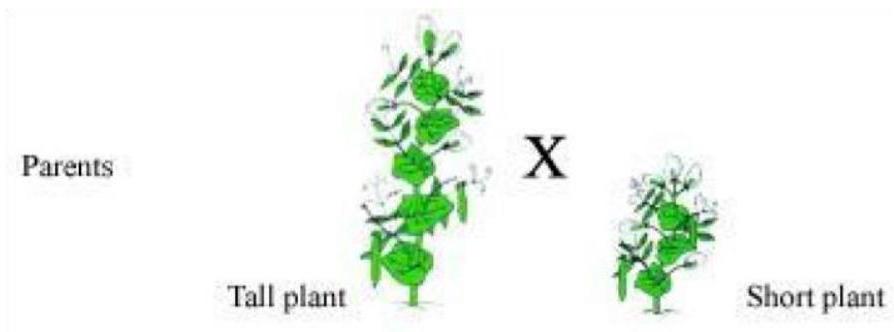
2. How do Mendel’s experiments show that traits are inherited independently?
Show Answer
Answer
Mendel crossed pea plants having round green seeds (RRyy) with pea plants having wrinkled yellow seeds (rrYY).
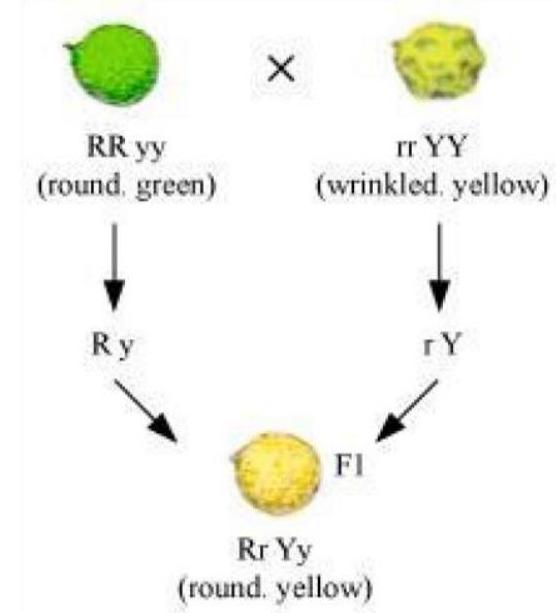
3. A man with blood group A marries a woman with blood group $O$ and their daughter has blood group $O$. Is this information enough to tell you which of the traits - blood group A or O - is dominant? Why or why not?
Show Answer
Answer
No. This information is not sufficient to determine which of the traits - blood group A or $O$ - is dominant. This is because we do not know about the blood group of all the progeny.
Blood group A can be genotypically AA or AO. Hence, the information is incomplete to draw any such conclusion.
4. How is the sex of the child determined in human beings?
Show Answer
Answer
In human beings, the females have two $X$ chromosomes and the males have one $X$ and one $Y$ chromosome. Therefore, the females are $XX$ and the males are $XY$.
The gametes, as we know, receive half of the chromosomes. The male gametes have 22 autosomes and either X or Y sex chromosome.
Type of male gametes: 22+X OR 22+ Y.
However, since the females have XX sex chromosomes, their gametes can only have $X$ sex chromosome.
Type of female gamete: 22+ X

Sex determination in humans
Thus, the mother provides only $X$ chromosomes. The sex of the baby is determined by the type of male gamete ( $X$ or $Y$ ) that fuses with the $X$ chromosome of the female.
What you have learnt
- Variations arising during the process of reproduction can be inherited.
- These variations may lead to increased survival of the individuals.
- Sexually reproducing individuals have two copies of genes for the same trait. If the copies are not identical, the trait that gets expressed is called the dominant trait and the other is called the recessive trait.
- Traits in one individual may be inherited separately, giving rise to new combinations of traits in the offspring of sexual reproduction.
- Sex is determined by different factors in various species. In human beings, the sex of the child depends on whether the paternal chromosome is $X$ (for girls) or $Y$ (for boys).
EXERCISSES
1. A Mendelian experiment consisted of breeding tall pea plants bearing violet flowers with short pea plants bearing white flowers. The progeny all bore violet flowers, but almost half of them were short. This suggests that the genetic make-up of the tall parent can be depicted as
(a) TTWW
(b) TTww
(c) TtWW
(d) TtWw
Show Answer
Answer
(c) The genetic make-up of the tall parent can be depicted as TtWW
Since all the progeny bore violet flowers, it means that the tall plant having violet flowers has WW genotype for violet flower colour.
Since the progeny is both tall and short, the parent plant was not a pure tall plant. Its genotype must be Tt.
Therefore, the cross involved in the given question is
$TtWw \times ttww$
$\downarrow$
$TtWw-ttww$
Therefore, half the progeny is tall, but all of them have violet flowers.
2. A study found that children with light-coloured eyes are likely to have parents with light-coloured eyes. On this basis, can we say anything about whether the light eye colour trait is dominant or recessive? Why or why not?
Show Answer
Answer
Let us assume that children with light-coloured eyes can either have LL or Ll or ll genotype. If the children have LL genotype, then their parents will also be of LL genotype.

LL
If the children with light-coloured eyes have $1 l$ genotype, then their parents will also have $1 l$ genotype.
$11 \times l l$
$\downarrow$
ll
Therefore, it cannot be concluded whether light eye colour is dominant or recessive.
3. Outline a project which aims to find the dominant coat colour in dogs.
Show Answer
Answer
Dogs have a variety of genes that govern coat colour. There are at least eleven identified gene series (A, B, C, D, E, F, G, M, P, S, T) that influence coat colour in dog.
A dog inherits one gene from each of its parents. The dominant gene gets expressed in the phenotype. For example, in the B series, a dog can be genetically black or brown.
Let us assume that one parent is homozygous black (BB), while the other parent is homozygous brown (bb)
bb BB
B B
$bBbBb$
$bBbBb$
In this case, all the offsprings will be heterozygous (Bb).
Since black (B) is dominant, all the offsprings will be black. However, they will have both B and $b$ alleles.
If such heterozygous pups are crossed, they will produce 25% homozygous black (BB), $50 %$ heterozygous black ( $Bb$ ), and 25% homozygous brown (bb) offsprings.
B b
$BBBBb$
$bBbBb$
4. How is the equal genetic contribution of male and female parents ensured in the progeny?
Show Answer
Answer
In human beings, every somatic cell of the body contains 23 pairs of chromosomes. Out of these 23 pairs, the first 22 pairs are known as autosomes and the remaining one pair is known as sex chromosomes represented as $X$ and $Y$.
Females have two X chromosomes and males have one X and one Y chromosome.
The gamete receives half of the chromosomes. Therefore, the male gametes have 22 autosomes and either $X$ or $Y$ chromosome.
The female gamete, on the other hand, has 22 autosomes and X chromosome.
During reproduction, the male and female gametes fuse and thus the progeny receives 22 autosomes and one $X$ or $Y$ chromosome from male parent and 22 autosomes and one $X$ chromosome from the female parent.

Father 22 pairs of autosomes
XY
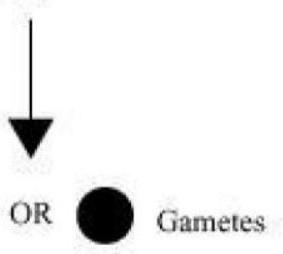

Mother
22 pairs of autosomes
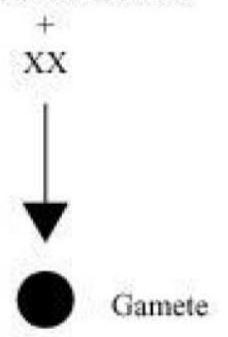
Gamete

22 pairs of autosomes OR 22 pairs of autosomes
$+$
XY
हमने देखा कि जनन प्रक्रमों द्वारा नए जीव (व्यष्टि) उत्पन्न होते हैं, जो जनक के समान होते हुए भी कुछ भिन्न होते हैं। हमने यह चर्चा की है कि अलैंगिक जनन में भी कुछ विभिन्नताएँ कैसे उत्पन्न होती हैं। अधिकतम संख्या में सफल विभिन्नताएँ लैंगिक प्रजनन द्वारा ही प्राप्त होती हैं। यदि हम गन्ने के खेत का अवलोकन करें तो हमें व्यष्टिगत पौधों में बहुत कम विभिन्नताएँ दिखाई पड़ती हैं। मानव एवं अधिकतर जंतु जो लैंगिक जनन द्वारा उत्पन्न होते हैं, इनमें व्यष्टिगत स्तर पर अनेक भिन्नताएँ परिलक्षित होती हैं। इस अध्याय में हम उन क्रियाविधियों का अध्ययन करेंगे, जिनके कारण विभिन्नताएँ उत्पन्न एवं वंशागत होती हैं।
8.1 जनन के दौरान विभिन्नताओं का संचयन
पूर्ववर्ती पीढ़ी से वंशागति संतति को एक आधारिक शारीरिक अभिकल्प (डिज़ाइन) एवं कुछ विभिन्नताएँ प्राप्त होती हैं। अब ज़रा सोचिए, कि इस नई पीढ़ी के जनन का क्या परिणाम होगा? दूसरी पीढ़ी में पहली पीढ़ी से आहरित विभिन्नताएँ एवं कुछ नई विभिन्नताएँ उत्पन्न होंगी।

चित्र 8.1 उत्तरोत्तर पीढ़ियों में विविधता की उत्पत्ति। शीर्ष पर दर्शाए गए पहली पीढ़ी के जीव, मान लीजिए कि दो संतति को जन्म देंगे, जिनकी आधारभूत शारीरिक संरचना तो एकसमान होगी, परंतु विभिन्नताएँ भी होंगी। इनमें से प्रत्येक अगली पीढ़ी में दो जीवों को उत्पन्न करेगा। चित्र में सबसे नीचे दिखाए गए चारों जीव व्यष्टि स्तर पर एक दसरे से भिन्न होंगे। कुछ विभिन्नताएँ विशिष्ट होंगी, जबकि कुछ उन्हें अपने जनक से प्राप्त हुई हैं जो स्वयं आपस में एक-दूसरे से भिन्न थे।
चित्र 8.1 में उस स्थिति को दर्शाया गया है जबकि केवल एकल जीव जनन करता है, जैसा कि अलैंगिक जनन में होता है। यदि एक जीवाणु विभाजित होता है, तो परिणामतः दो जीवाणु उत्पन्न होते हैं जो पुनः विभाजित होकर चार (व्यष्टि) जीवाणु उत्पन्न करेंगे, जिनमें आपस में बहुत अधिक समानताएँ होंगी। उनमें आपस में बहुत कम अंतर होगा, जो डी. एन. ए. प्रतिकृति के समय न्यून त्रुटियों के कारण उत्पन्न हुई होंगी। परंतु यदि लैंगिक जनन होता तो विविधता अपेक्षाकृत और अधिक होती। इसके विषय में हम आनुवंशिकता के नियमों की चर्चा के समय देखेंगे।
क्या किसी स्पीशीज में इन सभी विभिन्नताओं के साथ अपने अस्तित्व में रहने की संभावना एकसमान है? निश्चित रूप से नहीं। प्रकृति की विविधता के आधार पर विभिन्न जीवों को विभिन्न प्रकार के लाभ हो सकते हैं। ऊष्णता को सहन करने की क्षमता वाले जीवाणुओं को अधिक गर्मी से बचने की संभावना अधिक होती है। उसकी चर्चा हम पहले कर चुके हैं। पर्यावरण कारकों द्वारा उत्तम परिवर्त का चयन जैव विकास प्रक्रम का आधार बनाता है, जिसकी चर्चा हम आगे करेंगे।
प्रश्न
1. यदि एक ‘लक्षण - $\mathrm{A}$ ’ अलैंगिक प्रजनन वाली समष्टि के 10 प्रतिशत सदस्यों में पाया जाता है तथा ‘लक्षण - $\mathrm{B}$ ’ उसी समष्टि में 60 प्रतिशत जीवों में पाया जाता है, तो कौन-सा लक्षण पहले उत्पन्न हुआ होगा?
Show Answer
#missing2. विभिन्नताओं के उत्पन्न होने से किसी स्पीशीज का अस्तित्व किस प्रकार बढ़ जाता है?
Show Answer
#missing8.2 आनुवंशिकता
जनन प्रक्रम का सबसे महत्वपूर्ण परिणाम संतति के जीवों के समान डिज़ाइन (अभिकल्पना) का होना है। आनुवंशिकता नियम इस बात का निर्धारण करते हैं, जिनके द्वारा विभिन्न लक्षण पूर्ण विश्वसनीयता के साथ वंशागत होते हैं। आइए, इन नियमों का ध्यानपूर्वक अध्ययन करें।
8.2.1 वंशागत लक्षण
वास्तव में समानता एवं विभिन्नताओं से हमारा क्या अभिप्राय है? हम जानते हैं कि शिशु में मानव के सभी आधारभूत लक्षण होते हैं। फिर भी यह पूर्णरूप से अपने जनकों जैसा दिखाई नहीं पड़ता तथा मानव समष्टि में यह विभिन्नता स्पष्ट दिखाई देती है।
क्रियाकलाप 8.1
- अपनी कक्षा के सभी छात्रों के कान का अवलोकन कीजिए। ऐसे छात्रों की सूची बनाइए जिनकी कर्णपालि (ear lobe) स्वतंत्र हो तथा जुड़ी हो (चित्र 8.2)। जुड़े कर्णपालि वाले छात्रों एवं स्वतंत्र कर्णपालि वाले छात्रों के प्रतिशत की गणना कीजिए। प्रत्येक छात्र के कर्णपालि के प्रकार को उनके जनक से मिलाकर देखिए। इस प्रेक्षण के आधार पर कर्णपालि के वंशागति के संभावित नियम का सुझाव दीजिए।

(a)

(b)
चित्र 8.2 (a) स्वतंत्र तथा (b) जुड़े कर्ण पालि। कान के निचले भाग को कर्णपालि कहते हैं। यह कुछ लोगों में सिर के पार्श्व में पूर्ण रूप से जुड़ा होता है परंतु कुछ में नहीं। स्वतंत्र एवं जुड़े कर्णपालि मानव समष्टि में पाए जाने वाले दो परिवर्त हैं।
8.2.2 लक्षणों की वंशागति के नियम— मेंडल का योगदान
मानव में लक्षणों की वंशागति के नियम इस बात पर आधारित हैं कि माता एवं पिता दोनों ही समान मात्रा में आनुवंशिक पदार्थ को संतति (शिशु) में स्थानांतरित करते हैं। इसका अर्थ यह है कि प्रत्येक लक्षण पिता और माता के डी.एन.ए. से प्रभावित हो सकते हैं। अतः प्रत्येक लक्षण के लिए प्रत्येक संतति में दो विकल्प होंगे। फिर संतान में कौन-सा लक्षण परिलक्षित होगा? मेंडल (बॉक्स में देखिए) ने इस प्रकार की वंशागति के कुछ मुख्य नियम प्रस्तुत किए। उन प्रयोगों के बारे में जानना अत्यंत रोचक होगा, जो उसने लगभग एक शताब्दी से भी पहले किए थे।
ग्रेगर जॉन मेंडल (1822-1884)

मेंडल की प्रारंभिक शिक्षा एक गिरजाघर में हुई थी तथा वह विज्ञान एवं गणित के अध्ययन के लिए वियना विश्वविद्यालय गए। अध्यापन हेतु सर्टिफिकेट की परीक्षा में असफल होना उनकी वैज्ञानिक खोज की प्रवृत्ति को दबा नहीं सका। वह अपनी मोनेस्ट्री में वापस गए तथा मटर पर प्रयोग करना प्रारंभ किया। उनसे पहले भी बहुत से वैज्ञानिकों ने मटर एवं अन्य जीवों के वंशागत गुणों का अध्ययन किया था, परंतु मेंडल ने अपने विज्ञान एवं गणितीय ज्ञान को समिश्रित किया। वह पहले वैज्ञानिक थे, जिन्होंने प्रत्येक पीढ़ी के एक-एक पौधे द्वारा प्रदर्शित लक्षणों का रिकॉर्ड रखा तथा गणना की। इससे उन्हें वंशागत नियमों के प्रतिपादन में सहायता मिली।
मेंडल ने मटर के पौधे के अनेक विपर्यासी (विकल्पी) लक्षणों का अध्ययन किया, जो स्थूल रूप से दिखाई देते हैं, उदाहरणतः गोल/झुर्रीदार बीज, लंबे/बौने पौधे, सफेद/बैंगनी फूल इत्यादि। उसने विभिन्न लक्षणों वाले मटर के पौधों को लिया जैसे कि लंबे पौधे तथा बौने पौधे। इससे प्राप्त संतति पीढ़ी में लंबे एवं बौने पौधों के प्रतिशत की गणना की।
प्रथम संतति पीढ़ी अथवा $F _{1}$ में कोई पौधा बीच की ऊँचाई का नहीं था। सभी पौधे लंबे थे। इसका अर्थ था कि दो लक्षणों में से केवल एक पैतक जनकीय लक्षण ही दिखाई देता है, उन दोनों का मिश्रित प्रभाव दृष्टिगोचर नहीं होता। तो अगला प्रश्न था कि क्या $\mathrm{F} _{1}$ पीढ़ी के पौधे अपने पैतॄक लंबे पौधों से पूर्ण रूप से समान थे? मेंडल ने अपने प्रयोगों में दोनों प्रकार के पैत्तक पौधों एवं $F _{1}$ पीढ़ी के पौधों को स्वपरागण द्वारा उगाया। पैतृक पीढ़ी के पौधों से प्राप्त सभी संतति भी लंबे पौधों की थी। परंतु $F _{1}$ पीढ़ी के लंबे पौधों की दूसरी पीढ़ी अर्थात $\mathrm{F} _{2}$ पीढ़ी के सभी पौधे लंबे नहीं थे वरन् उनमें से एक चौथाई संतति बौने पौधे थे। यह इंगित करता है कि $F$ पौधों द्वारा लंबाई एवं बौनेपन दोनों विशेषकों (लक्षणों) की वंशानुगति हुई। परंतु केवल लंबाई वाला लक्षण ही व्यक्त हो पाया। अतः लैंगिक जनन द्वारा उत्पन्न होने वाले जीवों में किसी भी लक्षण की दो प्रतिकृतियों की (स्वरूप) वंशानुगति होती है। ये दोनों एकसमान हो सकते हैं अथवा भिन्न हो सकते हैं, जो उनके जनक पर निर्भर करता है। इस परिकल्पना के आधार पर वंशानुगति का तैयार किया गया एक पैटर्न चित्र 8.3 में दर्शाया गया है।

चित्र 8.3 दो पीढ़ियों तक लक्षणों की वंशानुगति
क्रियाकलाप 8.2
- चित्र 8.3 में हम कौन सा प्रयोग करते हैं जिससे यह सुनिश्चित होता है कि $\mathrm{F} _{2}$ पीढ़ी में वास्तव में $\mathrm{TT}, \mathrm{Tt}$ तथा $\mathrm{tt}$ का संयोजन $1: 2: 1$ अनुपात में प्राप्त होता है?
इस व्याख्या में ’ $\mathrm{TT}$ ’ एवं ’ $\mathrm{Tt}$ ’ दोनों ही लंबे पौधे हैं, जबकि केवल ’ $\mathrm{tt}$ ’ बौने पौधे हैं। दूसरे शब्दों में, ’ $T$ ’ की एक प्रति ही पौधे को लंबा बनाने के लिए पर्याप्त है, जबकि बौनेपन के लिए ’ $t$ ’ की दोनों प्रतियाँ ’ $t$ ’ ही होनी चाहिए। ’ $T$ ’ जैसे लक्षण ‘प्रभावी’ लक्षण कहलाते हैं, जबकि जो लक्षण ’ $t$ ’ की तरह व्यवहार करते हैं ‘अप्रभावी’ कहलाते हैं। चित्र 8.4 में कौन-सा लक्षण प्रभावी है तथा कौन-सा अप्रभावी है।

चित्र 8.4
क्या होता है जब मटर के पौधों में एक विकल्पी जोड़े के स्थान पर दो विकल्पी जोड़ों का अध्ययन करने के लिए संकरण कराया जाए? गोल बीज वाले लंबे पौधों का यदि झुर्रीदार बीजों वाले बौने पौधों से संकरण कराया जाए तो प्राप्त संतति कैसी होगी? $F _{1}$ पीढ़ी के सभी पौधे लंबे एवं गोल बीज वाले होंगे। अतः लंबाई तथा गोल बीज ‘प्रभावी’ लक्षण हैं। परंतु क्या होता है जब $F _{1}$ संतति के स्वनिषेचन से $\mathrm{F} _{2}$ पीढ़ी की संतति प्राप्त होती है? मेंडल द्वारा किए गए पहले प्रयोग के आधार पर हम कह सकते हैं कि $\mathrm{F} _{2}$ संतति के कुछ पौधे गोल बीज वाले लंबे पौधे होंगे तथा कुछ झुर्रीदार बीज वाले बौने पौधे। परंतु $F _{2}$ की संतति के कुछ पौधे नए संयोजन प्रदर्शित करेंगे। उनमें से कुछ पौधे लंबे परंतु झुर्रीदार बीज तथा कुछ पौधे बौने परंतु गोल बीज वाले होंगे। यहाँ आप देख सकते हैं कि किस तरह $\mathrm{F} _{2}$ पीढ़ी में नए लक्षणों का संयोजन देखने को मिला जब बीज के आकार व रंग को नियंत्रित करने वाले कारकों के पुनर्संयोजन से युग्मनज बना जो $\mathrm{F} _{2}$ पीढ़ी में अग्रणी रहा। अतः लंबे/बौने लक्षण तथा गोल/ झुर्रीदार लक्षण स्वतंत्र रूप से वंशानुगत होते हैं। एक और उदाहरण चित्र 8.5 में दर्शाया गया है।

चित्र 8.5 दो अलग-अलग लक्षणों (बीजों की आकृति एवं रंग) की स्वतंत्र वंशानुगति
8.2.3 यह लक्षण अपने आपको किस प्रकार व्यक्त करते हैं?
आनुवंशिकता कार्य विधि किस प्रकार होती है? कोशिका के डी.एन.ए. में प्रोटीन संश्लेषण के लिए एक सूचना स्रोत होता है। डी.एन.ए. का वह भाग जिसमें किसी प्रोटीन संश्लेषण के लिए सूचना होती है, उस प्रोटीन का जीन कहलाता है। प्रोटीन विभिन्न लक्षणों की अभिव्यक्ति को किस प्रकार नियंत्रित करती है, इसकी हम यहाँ चर्चा करते हैं? आइए, पौधों की लंबाई के एक लक्षण को उदाहरण के रूप में लेते हैं। हम जानते हैं कि पौधों में कुछ हार्मोन होते हैं, जो लंबाई का नियंत्रण करते हैं। अतः किसी पौधे की लंबाई पौधे में उपस्थित उस हार्मोन की मात्रा पर निर्भर करती है। पौधे के हार्मोन की मात्रा उस प्रक्रम की दक्षता पर निर्भर करेगी, जिसके द्वारा यह उत्पादित होता है। एंज़ाइम इस प्रक्रम के लिए महत्वपूर्ण है। यदि यह एंज़ाइम (प्रकिण्व) दक्षता से कार्य करेगा तो हार्मोन पर्याप्त मात्रा में बनेगा तथा पौधा लंबा होगा। यदि इस प्रोटीन के जीन में कुछ परिवर्तन आते हैं तो बनने वाली प्रोटीन की दक्षता पर प्रभाव पड़ेगा वह कम दक्ष होगी। अतः बनने वाले हार्मोन की मात्रा भी कम होगी तथा पौधा बौना होगा। अतः जीन लक्षणों (traits) को नियंत्रित करते हैं।
यदि मेंडल के प्रयोगों की व्याख्या जिसकी हम चर्चा कर रहे थे, ठीक है तो इसकी चर्चा हम पिछले अध्याय में कर चुके हैं। लैंगिक प्रजनन के दौरान संतति के डी.एन.ए. में दोनों जनक का समान रूप से योगदान होगा। यदि दोनों जनक संतति के लक्षण के निर्धारण में सहायता करते हैं तो दोनों जनक एक ही जीन की एक प्रतिकृति संतति को प्रदान करेंगे। इसका अर्थ है कि मटर के प्रत्येक पौधे में सभी जीन के दो-सेट होंगे, प्रत्येक जनक से एक सेट की वंशानुगति होती है। इस तरीके को सफल करने के लिए प्रत्येक जनन कोशिका में जीन का केवल एक ही सेट होगा।
जबकि सामान्य कायिक कोशिका में जीन के सेट की दो प्रतियाँ (copies) होती हैं, फिर इनसे जनन कोशिका में इसका एक सेट किस प्रकार बनता है? यदि संतति पौधे को जनक पौधे से संपूर्ण जीनों का एक पूर्ण सेट प्राप्त होता है तो चित्र 8.5 में दर्शाया प्रयोग सफल नहीं हो सकता। इसका मुख्य कारण यह है कि दो लक्षण ’ $R$ ’ तथा ’ $y$ ’ सेट में एक-दूसरे से संलग्न रहेंगे तथा स्वतंत्र रूप में आहरित नहीं हो सकते। इसे इस तथ्य के आधार पर समझा जा सकता है कि वास्तव में एक जीन सेट केवल एक डी.एन.ए. श्रंखला के रूप में न होकर डी.एन.ए. के अलग-अलग स्वतंत्र रूप में होते हैं, प्रत्येक एक गुण सूत्र कहलाता है। अतः प्रत्येक कोशिका में प्रत्येक गुणसूत्र की दो प्रतिकृतियाँ होती हैं, जिनमें से एक नर तथा दूसरी मादा जनक से प्राप्त होती हैं। प्रत्येक जनक कोशिका (पैतृक अथवा मातृक) से गुणसूत्र के प्रत्येक जोड़े का केवल एक गुणसूत्र ही एक जनन कोशिका (युग्मक) में जाता है। जब दो युग्मकों का संलयन होता है तो बने हुए युग्मनज में गुणसूत्रों की संख्या पुनः सामान्य हो जाती है तथा संतति में गुणसूत्रों की संख्या निश्चित बनी रहती है, जो स्पीशीज के डी.एन.ए. के स्थायित्व को सुनिश्चित करता है। वंशागति की इस क्रियाविधि से मेंडल के प्रयोगों के परिणाम की व्याख्या हो जाती है। इसका उपयोग लैंगिक जनन वाले सभी जीव करते हैं, परंतु अलैंगिक जनन करने वाले जीव भी वंशागति के इन्हीं नियमों का पालन करते हैं। क्या हम पता लगा सकते हैं कि उनमें वंशानुगति किस प्रकार होती है?
8.2.4 लिंग निर्धारण
इस बात की चर्चा हम कर चुके हैं कि लैंगिक जनन में भाग लेने वाले दो एकल जीव किसी न किसी रूप में एक-दूसरे से भिन्न होते हैं, जिसके कई कारण हैं। नवजात का लिंग निर्धारण कैसे होता है? अलग-अलग स्पीशीज इसके लिए अलग-अलग युक्ति अपनाते हैं। कुछ पूर्ण रूप से पर्यावरण पर निर्भर करते हैं। इसलिए कुछ प्राणियों में (जैसे कुछ सरीसृप) लिंग निर्धारण निषेचित अंडे (युग्मक) के ऊष्मायन ताप पर निर्भर करता है कि संतति नर होगी या मादा। घोंघे जैसे कुछ प्राणी अपना लिंग बदल सकते हैं, जो इस बात का संकेत है कि इनमें लिंग निर्धारण आनुवंशिक नहीं है, लेकिन, मानव में लिंग निर्धारण आनुवंशिक आधार पर होता है। दूसरे शब्दों में, जनक जीवों से वंशानुगत जीन ही इस बात का निर्णय करते हैं कि संतति लड़का होगा अथवा लड़की, परंतु अभी तक हम मानते रहे हैं कि दोनों जनकों से एक जैसे जीन सेट संतति में जाते हैं। यदि यह शाश्वत नियम है तो फिर लिंग निर्धारण वंशानुगत कैसे हो सकता है?

चित्र 8.6 मानव में लिंग निर्धारण
इसकी व्याख्या इस तथ्य में निहित है कि मानव के सभी गुणसूत्र पूर्णरूपेण युग्म नहीं होते। मानव में अधिकतर गुणसूत्र माता और पिता के गुणसूत्रों के प्रतिरूप होते हैं। इनकी संख्या 22 जोड़े हैं। परंतु एक युग्म जिसे लिंग सूत्र कहते हैं, जो सदा पूर्णजोड़े में नहीं होते। स्री में गुणसूत्र का पूर्ण युग्म होता है तथा दोनों ’ $X$ ’ कहलाते हैं। लेकिन पुरुष (नर) में यह जोड़ा परिपूर्ण जोड़ा नहीं होता, जिसमें एक गुण सूत्र सामान्य आकार का ’ $\mathrm{X}$ ’ होता है तथा दूसरा गुणसूत्र छोटा होता है, जिसे ’ $Y$ ’ गुणसूत्र कहते हैं। अतः स्त्रियों में ’ $X X$ ’ तथा पुरुष में ’ $X Y$ ’ गुणसूत्र होते हैं। क्या अब हम $\mathrm{X}$ और $\mathrm{Y}$ का वंशानुगत पैटर्न पता कर सकते हैं?
जैसा कि चित्र 8.6 में दर्शाया गया है, सामान्यतः आधे बच्चे लड़के एवं आधे लड़की हो सकते हैं। सभी बच्चे चाहे वह लड़का हो अथवा लड़की, अपनी माता से ’ $X$ ’ गुणसूत्र प्राप्त करते हैं। अतः बच्चों का लिंग निर्धारण इस बात पर निर्भर करता है कि उन्हें अपने पिता से किस प्रकार का गुणसूत्र प्राप्त हुआ है। जिस बच्चे को अपने पिता से ’ $\mathrm{X}$ ’ गुणसूत्र वंशानुगत हुआ है वह लड़की एवं जिसे पिता से ’ $Y$ ’ गुणसूत्र वंशानुगत होता है, वह लड़का।
प्रश्न
1. मेंडल के प्रयोगों द्वारा कैसे पता चला कि लक्षण प्रभावी अथवा अप्रभावी होते हैं?
Show Answer
#missing2. मेंडल के प्रयोगों से कैसे पता चला कि विभिन्न लक्षण स्वतंत्र रूप से वंशानुगत होते हैं?
Show Answer
#missing3. एक ’ $A$-रुधिर वर्ग’ वाला पुरुष एक स्त्री जिसका रुधिर वर्ग ’ $\mathrm{O}$ ’ है, से विवाह करता है। उनकी पुत्री का रुधिर वर्ग - ’ $O$ ’ है। क्या यह सचचा पर्याप्त है यदि आपसे कहा जाए कि कौन सा विकल्प लक्षणरुधिर वर्ग- ’ $\mathrm{A}$ ’ अथवा ’ $\mathrm{O}$ ’ प्रभावी लक्षण हैं? अपने उत्तर का स्पष्टीकरण दीजिए।
Show Answer
#missing4. मानव में बच्चे का लिंग निर्धारण कैसे होता है?
Show Answer
#missingआपने क्या सीखा
- जनन के समय उत्पन्न विभिन्नताएँ वंशानुगत हो सकती हैं।
- इन विभिन्नताओं के कारण जीव की उत्तरजीविता में वृद्धि हो सकती है।
- लैंगिक जनन वाले जीवों में एक अभिलक्षण (Trait) के जीन के दो प्रतिरूप (Copies) होते हैं। इन प्रतिरूपों के एकसमान न होने की स्थिति में जो अभिलक्षण व्यक्त होता है उसे प्रभावी लक्षण तथा अन्य को अप्रभावी लक्षण कहते हैं।
- विभिन्न लक्षण किसी जीव में स्वतंत्र रूप से वंशानुगत होते हैं। संतति में नए संयोग उत्पन्न होते हैं।
- विभिन्न स्पीशीज़ में लिंग निर्धारण के कारक भिन्न होते हैं। मानव में संतान का लिंग इस बात पर निर्भर करता है कि पिता से मिलने वाले गुणसूत्र ’ $X$ ’ (लड़कियों के लिए) अथवा ’ $Y$ ’ (लड़कों के लिए) किस प्रकार के हैं।
अभ्यास
1. मेंडल के एक प्रयोग में लंबे मटर के पौधे जिनके बैंगनी पुष्प थे, का संकरण बौने पौधों जिनके सफेद पुष्प थे, से कराया गया। इनकी संतति के सभी पौधों में पुष्प बैंगनी रंग के थे। परंतु उनमें से लगभग आधे बौने थे। इससे कहा जा सकता है कि लंबे जनक पौधों की आनुवंशिक रचना निम्न थी-
(a) TTWW
(b) TTww
(c) TtWW
(d) TtWw
Show Answer
#missing2. एक अध्ययन से पता चला कि हल्के रंग की आँखों वाले बच्चों के जनक (माता-पिता) की आँखें भी हल्के रंग की होती हैं। इसके आधार पर क्या हम कह सकते हैं कि आँखों के हल्के रंग का लक्षण प्रभावी है अथवा अप्रभावी? अपने उत्तर की व्याख्या कीजिए।
Show Answer
#missing3. कुत्ते की खाल का प्रभावी रंग ज्ञात करने के उद्देश्य से एक प्रोजेक्ट बनाइए।
Show Answer
#missing4. संतति में नर एवं मादा जनकों द्वारा आनुवंशिक योगदान में बराबर की भागीदारी किस प्रकार सुनिश्चित की जाती है।










